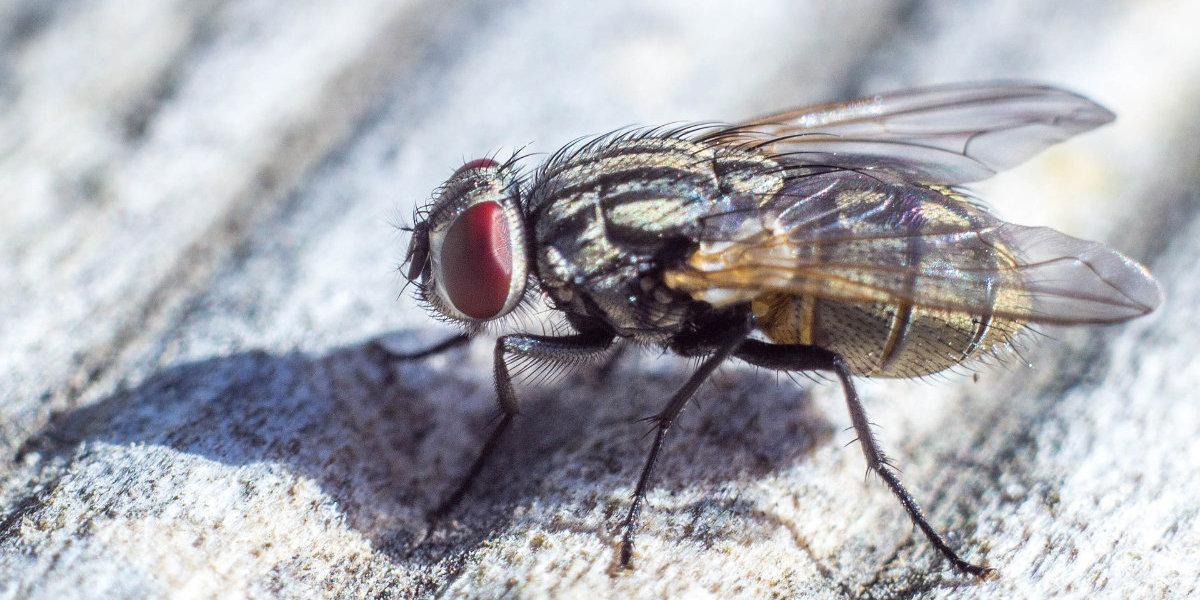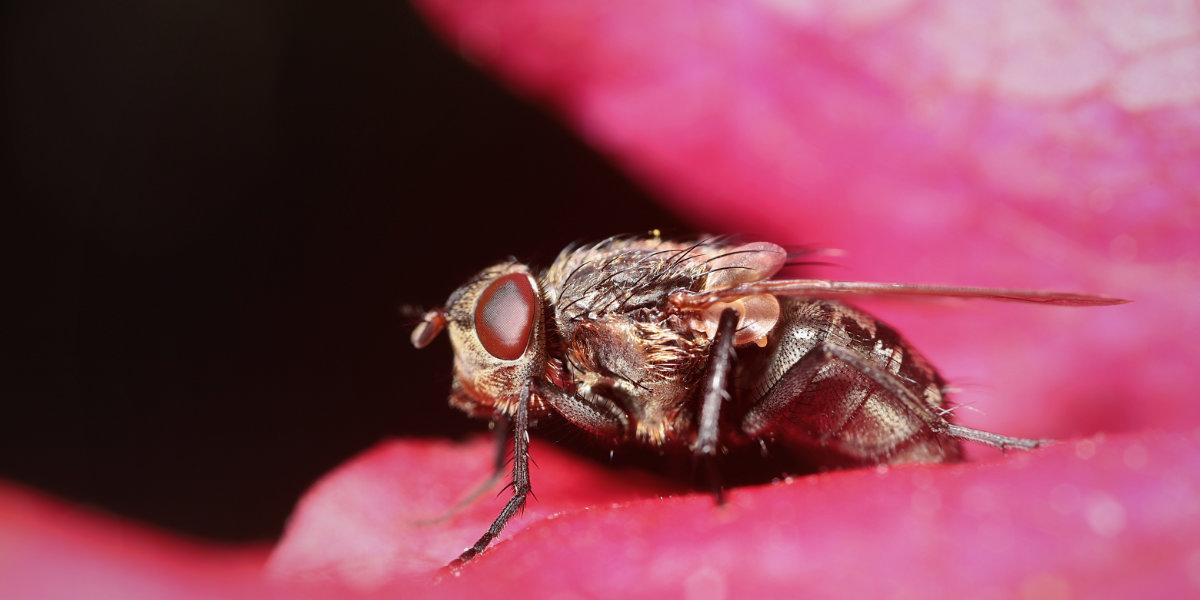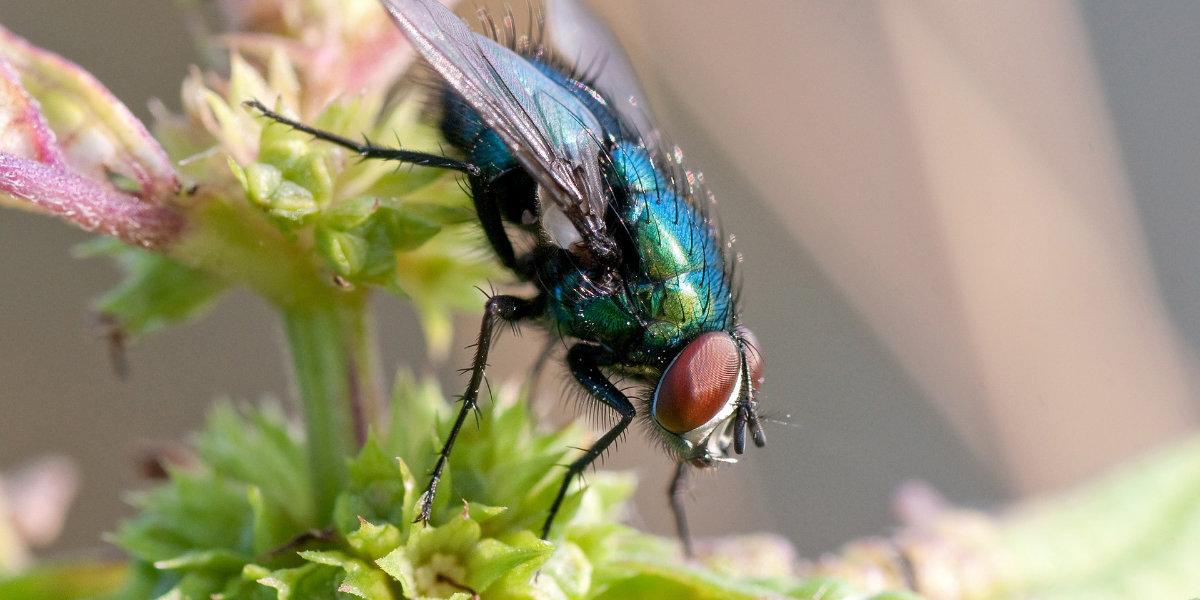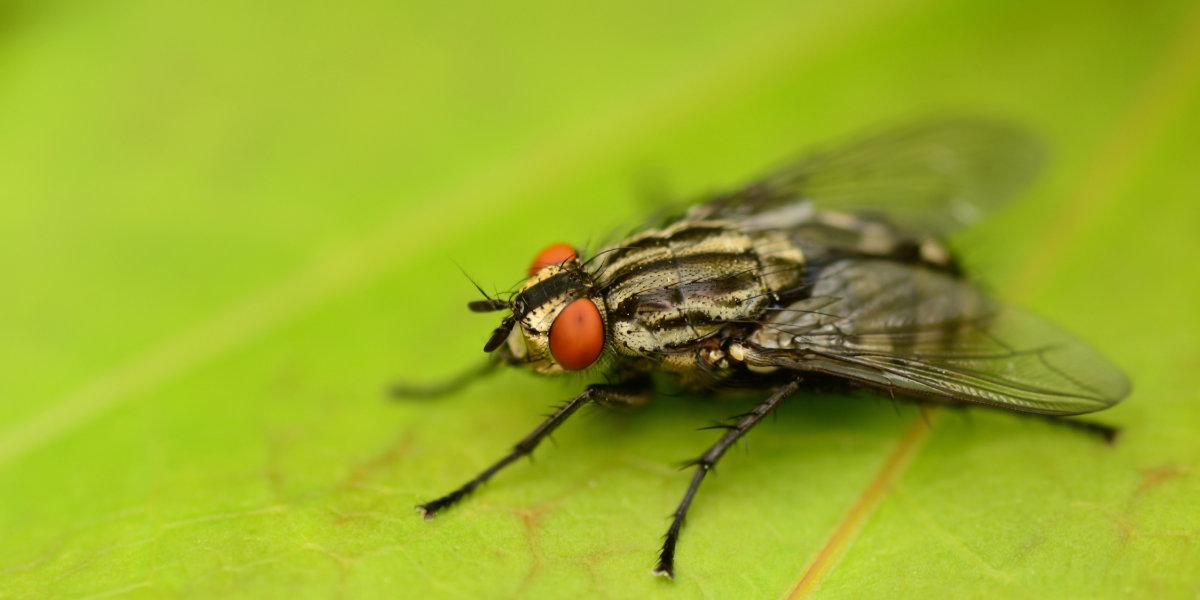Types of Flies in the UK

There are a whopping 120,000 different species of flies in the world — and those are just the ones we know about!
Luckily, only a few of these species live in the UK, and even fewer are found around the home. While all UK fly species have some common traits, many species differ in how they look, what they’re attracted by and which methods are needed to remove or repel them.
Have you got a fly infestation in your property? Our guide to common UK fly species will help you identify the types of flies in your house. Read the article to find out how to remove the infestations and prevent them from recurring.
Bluebottle Fly
What do they look like?
Bluebottle flies are a similar size to the common housefly (around 5-8mm in length) but can be easily identified by their distinct ‘metallic-blue’ colour.
They have large red eyes and transparent wings. Their larva is a white or tan colour, usually resembling small grubs.
Where are they found?
The bluebottle fly is common in most continents, including Africa and America, but you’ll most likely spot them lingering on the walls and windows of your home.
What attracts them to the home?
These flies tend to enter the home looking for a place to keep warm and nourished during winter.
They are particularly attracted to decaying flesh, so an infestation of bluebottle flies may indicate a dead or decaying animal in your attic or walls. They may also be attracted by pet faeces and household waste.
How to prevent and get rid of them?
Locate and remove the source of the infestation and the flies should follow. If they are hovering near your rubbish bin, it might be time to take it out. If your infestation is due to a decaying animal, you’ll need to remove the carcass. This may be best handled by a specialist.
To prevent bluebottle flies from getting into your house in the first place, try to keep windows and doors closed as much as you can — or invest in an insect-proof screen.
For total removal and prevention, Pest Defence offer a range of solutions, including electronic fly killers and fly screen windows and doors.
Autumn Fly (Musca autumnalis)
What do they look like?
The female autumn fly is almost identical to the common housefly. The males, however, are distinguishable by their orange abdomen with black stripes.
The fly has large red eyes and clear wings. The female flies are generally larger than the male flies at approximately 6-7mm in length.
Where are they found?
You might find Autumn flies around your home, but you may also find them around the eyes and nose of cattle or pet horses. Autumn flies irritate these animals by feeding from their saliva and transmitting diseases.
What attracts them to the home?
Autumn flies tend to enter buildings during Autumn to prepare for winter hibernation. They will seek out houses where they can sense a food supply.
How to prevent and get rid of them?
You can prevent Autumn flies from entering your property by keeping all windows closed as much as possible and sealing up any gaps. You can also use an insect-proof screen.
Pest Defence offer methods of removing Autumn flies and preventing others from returning. These include insecticides, electric fly killer and fly screens.
Cluster fly

What do they look like?
Cluster flies span between 6-10mm in length but most are larger than the common housefly. They have a dark grey-olive thorax covered with golden-brown hairs. They are distinguishable by their wings that overlap when at rest.
Where are they found?
Cluster flies typically enter higher levels of the building, so you’re most likely to find these flies in your attic. During sunny winter days, cluster flies may become warm and try to travel towards light, which is why you’ll often find cluster flies (especially dead ones) near your window.
What attracts them to the home?
Cluster flies live outdoors in the summer but, like the Autumn fly, enter buildings during the colder months to hibernate somewhere warm.
How to prevent and get rid of them?
Cluster flies can be difficult to manage because they live in hard-to-reach areas, such as wall voids and attics. Pest Defence use insecticides, as well as electronic fly killers to remove cluster flies from your property and prevent others from entering.
For more information, please see our guide to getting rid of cluster flies.
Fruit fly
What do they look like?
Fruit flies are particularly small — around 3mm in length. Their abdomen is black on top and grey underneath and their thorax is a light yellow/tan colour.
Like many flies, fruit flies have large red eyes and transparent wings. Their abdomen hangs down low, which makes them slower than most flies.
Where are they found?
Fruit flies tend to be found in the kitchen or other areas containing food. You may also find these flies in mop buckets, wheelie bins and drains.
What attracts them to the home?
Fruit flies seek out fermenting organic matter, such as rotten fruit or soured milk, to lay their eggs onto. Fruit fly larvae feed on the fungi found in decaying food. If not swiftly eliminated, fruit fly larvae will turn the food into a semi-liquid mess.
How to prevent and get rid of them?
It’s not enough to simply get rid of the fruit flies — the larval site must also be identified and removed. Any remaining flies can be controlled using a residual insecticide or ULV treatment.
Pest Defense offers a range of methods for controlling, eliminating and preventing fruit flies. This includes insecticides, ULV treatments and electric fly killers.
Housefly
What do they look like?
Houseflies are typically grey and between 5-8mm in length. They have a yellow abdomen and a grey thorax with narrow stripes.
Houseflies have large red eyes and slightly pointed wings. They are covered in hairs that serve as taste organs.
Where are they found?
The housefly can be found all over the world and is the most common type of fly in the UK to be found in houses. If you notice a fly buzzing around your home, it’s most likely a housefly. They usually find their way through windows — an unsealed crack in a window can lead to an infestation.
What are they attracted by?
Houseflies are attracted to all things filthy — rotting food, faeces, rubbish bins, decaying animals.
How to prevent and get rid of them?
Keep your home clean to prevent houseflies. Make sure you take out your rubbish regularly and promptly dispose of any food that is showing signs of decay.
Pest Defence can implement insect-proof screen and electronic fly killers to remove and prevent nuisance flies.
Fly Facts & FAQs
What kills flies?
Flies can be killed with electric fly killers and insecticides.
What repels flies?
Cinnamon is effective at repelling flies, as are essential oils such as lavender, eucalyptus, peppermint and lemongrass.
How do you get rid of flies naturally?
A fly repellent should be administered. Natural fly repellents can be from herbs and oils, vinegar and soap, or cayenne pepper and water.
What are flies attracted to?
Flies are generally attracted to filth — rotting food, faeces, rubbish bins, decaying animals.
Do house flies bite?
The common housefly doesn’t bite but some other species do. Luckily, most of these bites are mildly annoying at worst. Diseases can be transmitted through fly bites, however.
Are flies dangerous?
Most British flies are a nuisance but don’t cause harm. However, some species, including cluster flies, can spread diseases to humans and should be considered dangerous. For more info, read What Diseases Are Carried And Transmitted By Flies?
How do flies get into the house?
Some flies will get into your house through plug sockets or skirting baseboards, while others will simply fly through an open window.
How do flies reproduce?
Flies reproduce sexually, which means mating requires a male and a female fly.
How do flies breed?
The female fly will produce eggs. She will often lay them on decaying food so that the larvae can feed on the fungi.
Why are flies in my house?
Flies may be attracted to your rubbish bin or may simply be looking for a warm place to hibernate for winter. If you notice a cluster of flies on a wall, there may be a decaying animal inside.
How long do flies live?
Different fly types have different lifespans, but the common housefly lives for 28 days on average. Sometimes they can live up to a month.
What do house flies eat?
House flies typically feed on decaying matter but may also feed on sweet items like sugar and nectar.
How many wings does a fly have?
All flies have two wings — counting the wings is a good way to distinguish a fly from similar flying insects.
How many legs do flies have?
Flies have 6 legs, which are all connected to the thorax.
Where do flies go at night?
Flies mostly sleep at night and so will seek out sleeping areas that keep them protected from predators, such as under leaves or twigs.
How fast do flies fly?
Different species of fly travel at varying speeds. The common housefly has a maximum flying speed of five miles per hour.
What do fly eggs look like?
Housefly eggs resemble small grains of rice. They will usually hatch larvae within 24 hours. Larvae may appear similar to small grubs or pale worms.
Pest Defence have over 30 years’ experience providing solutions for fly infestations and other pest issues. We will visit your premises and perform an inspection to identify the scope of the infestation. We will then create a solution that is tailored to your specific issue. This solution will involve the eradication of the pests, along with any nests, and we will put measures in place to prevent the infestation from recurring.
If you need pest control services in Colchester, Chelmsford, Brentwood and the surrounding Essex areas, give our team a call today.




